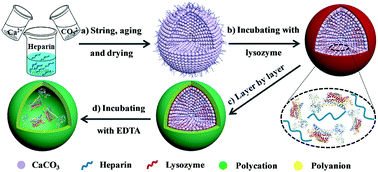A facile and efficient strategy to encapsulate the model basic protein lysozyme into porous CaCO3†
Abstract
Basic proteins play important roles in biological activities and disease treatment, but their high sensitivity to the body environment and short life time have limited their applications. Encapsulating the proteins into carriers has been demonstrated to be an effective way to prolong the protein half life time and to control the release temporally and spatially. However, fabricating protein carriers with high protein loading efficacy under mild conditions is still a big challenge. The capsules generated by the combination of the layer by layer (LBL) technique and sacrificial templates have been extensively investigated for the encapsulation of proteins. Porous CaCO3 is an effective sacrificial template with the ability to load various drugs efficiently under mild conditions, but it shows very poor ability in loading basic proteins. Here, we developed a highly efficient but very simple method to encapsulate lysozyme into porous CaCO3. An efficiency of 99.5% and capacity of 91.6 mg g−1 under very gentle conditions were obtained by doping heparin into porous CaCO3. Most importantly, the activity of the encapsulated lysozyme was almost 100% retained. Furthermore, we evaluated the encapsulation efficiency of the loaded lysozyme during the LBL wrapping process and demonstrated that the loss of the loaded lysozyme was controllable by choosing suitable polyelectrolyte pairs. Considering the multi-interaction mode of heparin with various proteins and the ability to retain the function of the loaded protein demonstrated in our study, we believe that the developed approach has great potential for encapsulating various functional proteins with a wide range of applications in catalysis, disease treatment, and tissue engineering.



 Please wait while we load your content...
Please wait while we load your content...